On-Substrate Joule Effect Heating by Printed Micro-Heater for the Preparation of ZnO Semiconductor Thin Film
Abstract
1. Introduction
2. Materials and Methods
3. Results
3.1. Sintering of Printed Silver
3.2. Temperature Survey of Joule Heating
3.3. Generation of ZnO by Joule Heating
3.4. UV Light Sensing Performance of the Sensor
4. Discussion
5. Conclusions
Author Contributions
Funding
Acknowledgments
Conflicts of Interest
Appendix A
| Zn:O Atomic Ratio | ||||||||
|---|---|---|---|---|---|---|---|---|
| Location | 1 | 2 | 3 | 4 | 5 | 6 | Average | Standard Deviation |
| 0 W | 0.430 | 0.431 | 0.422 | 0.390 | 0.292 | 0.305 | 0.378 | 0.058 |
| 4 W | 0.536 | 0.545 | 0.504 | 0.705 | 0.681 | 0.557 | 0.588 | 0.076 |
| 5 W | 0.553 | 0.567 | 0.517 | 0.691 | 0.651 | 0.648 | 0.605 | 0.062 |

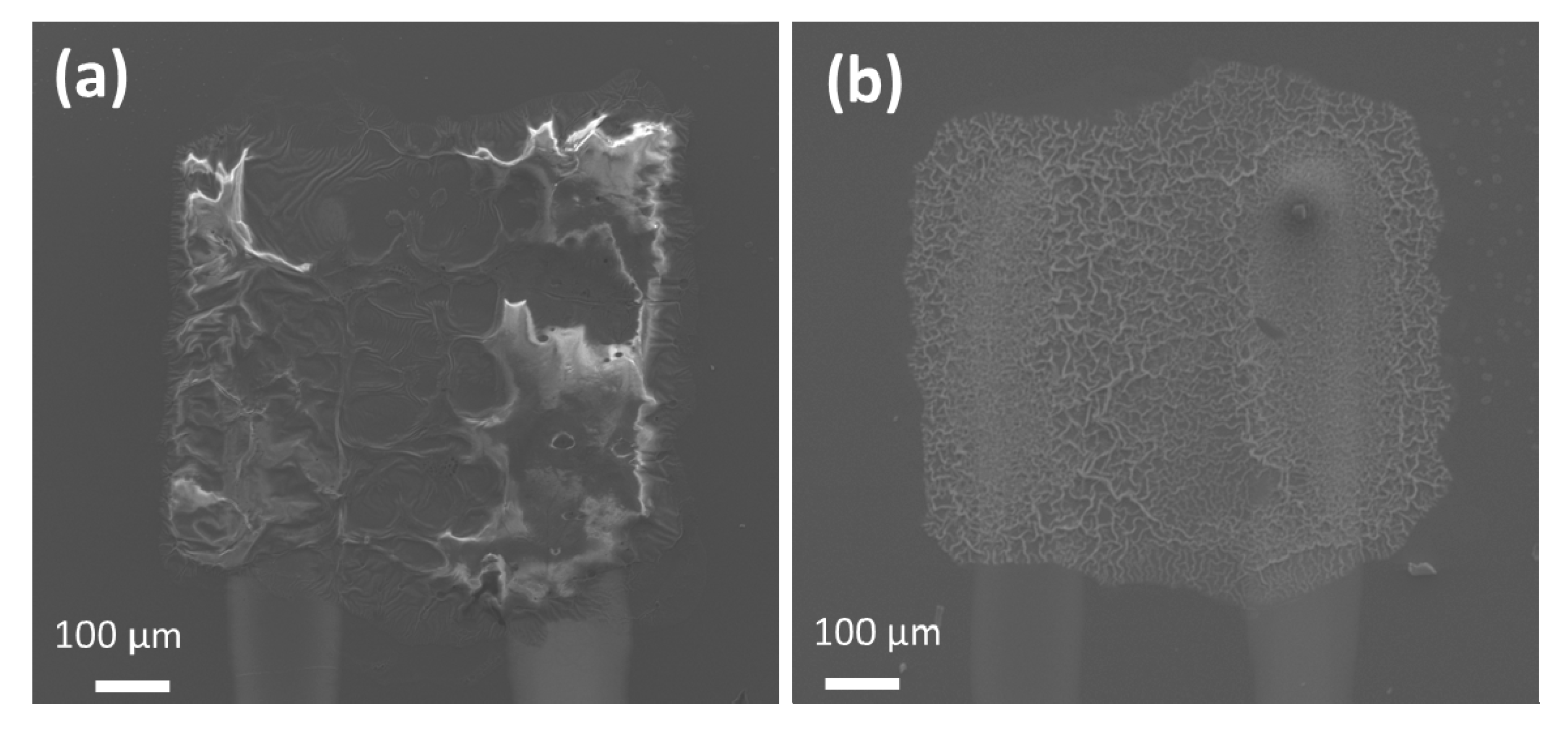
References
- Zhan, Z.; An, J.; Wei, Y.; Tran, V.T.; Du, H. Inkjet-printed optoelectronics. Nanoscale 2017, 9, 965–993. [Google Scholar] [CrossRef]
- Nayak, L.; Mohanty, S.; Nayak, S.K.; Ramadoss, A. A review on inkjet printing of nanoparticle inks for flexible electronics. J. Mater. Chem. C 2019, 7, 8771–8795. [Google Scholar] [CrossRef]
- Tran, V.-T.; Wei, Y.; Yang, H.; Zhan, Z.; Du, H. All-inkjet-printed flexible ZnO micro photodetector for a wearable UV monitoring device. Nanotechnology 2017, 28, 095204. [Google Scholar] [CrossRef]
- Yus, J.; Gonzalez, Z.; Sanchez-Herencia, A.J.; Sangiorgi, A.; Sangiorgi, N.; Gardini, D.; Sanson, A.; Galassi, C.; Caballero, A.; Morales, J.; et al. Semiconductor water-based inks: Miniaturized NiO pseudocapacitor electrodes by inkjet printing. J. Eur. Ceram. Soc. 2019, 39, 2908–2914. [Google Scholar] [CrossRef]
- Sanchez, J.G.; Balderrama, V.S.; Garduno, S.I.; Osorio, E.; Viterisi, A.; Estrada, M.; Ferre-Borrull, J.; Pallares, J.; Marsal, L.F. Impact of inkjet printed ZnO electron transport layer on the characteristics of polymer solar cells. RSC Adv. 2018, 8, 13094–13102. [Google Scholar] [CrossRef]
- Ganesan, S.; Gollu, S.R.; Alam khan, J.; Kushwaha, A.; Gupta, D. Inkjet printing of zinc oxide and P3HT:ICBA in ambient conditions for inverted bulk heterojunction solar cells. Opt. Mater. 2019, 94, 430–435. [Google Scholar] [CrossRef]
- Hasan, K.u.; Nur, O.; Willander, M. Screen printed ZnO ultraviolet photoconductive sensor on pencil drawn circuitry over paper. Appl. Phys. Lett. 2012, 100, 211104. [Google Scholar] [CrossRef]
- Liang, Y.N.; Lok, B.K.; Wang, L.; Feng, C.; Lu, A.C.W.; Mei, T.; Hu, X. Effects of the morphology of inkjet printed zinc oxide (ZnO) on thin film transistor performance and seeded ZnO nanorod growth. Thin Solid Films 2013, 544, 509–514. [Google Scholar] [CrossRef]
- Jiang, L.; Li, J.; Huang, K.; Li, S.; Wang, Q.; Sun, Z.; Mei, T.; Wang, J.; Zhang, L.; Wang, N.; et al. Low-Temperature and Solution-Processable Zinc Oxide Transistors for Transparent Electronics. ACS Omega 2017, 2, 8990–8996. [Google Scholar] [CrossRef]
- Friedmann, D.; Lee, A.F.; Wilson, K.; Jalili, R.; Caruso, R.A. Printing approaches to inorganic semiconductor photocatalyst fabrication. J. Mater. Chem. A 2019, 7, 10858–10878. [Google Scholar] [CrossRef]
- Gagnon, J.C.; Presley, M.; Le, N.Q.; Montalbano, T.J.; Storck, S. A pathway to compound semiconductor additive manufacturing. MRS Commun. 2019, 9, 1001–1007. [Google Scholar] [CrossRef]
- Chae, D.; Kim, J.; Shin, J.; Lee, W.H.; Ko, S. A low-temperature and short-annealing process for metal oxide thin film transistors using deep ultraviolet light for roll-to-roll processing. Curr. Appl. Phys. 2019, 19, 954–960. [Google Scholar] [CrossRef]
- Jeon, J.B.; Kim, B.J.; Bang, G.J.; Kim, M.-C.; Lee, D.G.; Lee, J.M.; Lee, M.; Han, H.S.; Boschloo, G.; Lee, S.; et al. Photo-annealed amorphous titanium oxide for perovskite solar cells. Nanoscale 2019, 11, 19488–19496. [Google Scholar] [CrossRef]
- Palneedi, H.; Park, J.H.; Maurya, D.; Peddigari, M.; Hwang, G.-T.; Annapureddy, V.; Kim, J.-W.; Choi, J.-J.; Hahn, B.-D.; Priya, S.; et al. Laser Irradiation of Metal Oxide Films and Nanostructures: Applications and Advances. Adv. Mater. 2018, 30, 1705148. [Google Scholar] [CrossRef]
- Sharma, S.; Pande, S.S.; Swaminathan, P. Top-down synthesis of zinc oxide based inks for inkjet printing. RSC Adv. 2017, 7, 39411–39419. [Google Scholar] [CrossRef]
- Rao, A.; Long, H.; Harley-Trochimczyk, A.; Pham, T.; Zettl, A.; Carraro, C.; Maboudian, R. In Situ Localized Growth of Ordered Metal Oxide Hollow Sphere Array on Microheater Platform for Sensitive, Ultra-Fast Gas Sensing. ACS Appl. Mater. Interfaces 2017, 9, 2634–2641. [Google Scholar] [CrossRef]
- Yan, H.; Wu, H. Joule Heating and Chip Materials. In Encyclopedia of Microfluidics and Nanofluidics; Li, D., Ed.; Springer: Boston, MA, USA, 2013. [Google Scholar]
- Nguyen, H.; Quy, C.T.; Hoa, N.D.; Lam, N.T.; Duy, N.V.; Quang, V.V.; Hieu, N.V. Controllable growth of ZnO nanowires grown on discrete islands of Au catalyst for realization of planar-type micro gas sensors. Sens. Actuators Chem. 2014, 193, 888–894. [Google Scholar] [CrossRef]
- Long, H.; Turner, S.; Yan, A.; Xu, H.; Jang, M.; Carraro, C.; Maboudian, R.; Zettl, A. Plasma assisted formation of 3D highly porous nanostructured metal oxide network on microheater platform for Low power gas sensing. Sens. Actuators Chem. 2019, 301, 127067. [Google Scholar] [CrossRef]
- Dai, C.-L. A capacitive humidity sensor integrated with micro heater and ring oscillator circuit fabricated by CMOS–MEMS technique. Sens. Actuators Chem. 2007, 122, 375–380. [Google Scholar] [CrossRef]
- Nerushev, O.A.; Ek-Weis, J.; Campbell, E.E.B. In situ studies of growth of carbon nanotubes on a local metal microheater. Nanotechnology 2015, 26, 505601. [Google Scholar] [CrossRef][Green Version]
- Kwon, J.; Hong, S.; Kim, G.; Suh, Y.D.; Lee, H.; Choo, S.-Y.; Lee, D.; Kong, H.; Yeo, J.; Ko, S.H. Digitally patterned resistive micro heater as a platform for zinc oxide nanowire based micro sensor. Appl. Surf. Sci. 2018, 447, 1–7. [Google Scholar] [CrossRef]
- Tran, V.-T.; Wei, Y.; Liau, W.; Yang, H.; Du, H. Preparing of Interdigitated Microelectrode Arrays for AC Electrokinetic Devices Using Inkjet Printing of Silver Nanoparticles Ink. Micromachines 2017, 8, 106. [Google Scholar] [CrossRef]
- Ravindra, N.M.; Abedrabbo, S.; Wei, C.; Tong, F.M.; Nanda, A.K.; Speranza, A.C. Temperature-dependent emissivity of silicon-related materials and structures. IEEE Tran. Semicond. Manuf. 1998, 11, 30–39. [Google Scholar] [CrossRef]
- Lee, S.M.; Dyer, D.C.; Gardner, J.W. Design and optimisation of a high-temperature silicon micro-hotplate for nanoporous palladium pellistors. Microelectron. J. 2003, 34, 115–126. [Google Scholar] [CrossRef]
- Paraguay D, F.; Estrada L, W.; Acosta N, D.R.; Andrade, E.; Miki-Yoshida, M. Growth, structure and optical characterization of high quality ZnO thin films obtained by spray pyrolysis. Thin Solid Films 1999, 350, 192–202. [Google Scholar] [CrossRef]
- Lin, C.-C.; Li, Y.-Y. Synthesis of ZnO nanowires by thermal decomposition of zinc acetate dihydrate. Mater. Chem. Physi. 2009, 113, 334–337. [Google Scholar] [CrossRef]
- Kwon, S.J.; Park, J.-H.; Park, J.-G. Wrinkling of a sol-gel-derived thin film. Phys. Rev. E 2005, 71, 011604. [Google Scholar] [CrossRef]
- Justin Raj, C.; Karthick, S.N.; Hemalatha, K.V.; Kim, S.-K.; Kim, B.C.; Yu, K.-H.; Kim, H.-J. Synthesis of self-light-scattering wrinkle structured ZnO photoanode by sol–gel method for dye-sensitized solar cells. Appl. Phys. A 2014, 116, 811–816. [Google Scholar] [CrossRef]
- Liu, X.; Gu, L.; Zhang, Q.; Wu, J.; Long, Y.; Fan, Z. All-printable band-edge modulated ZnO nanowire photodetectors with ultra-high detectivity. Nat. Commun. 2014, 5. [Google Scholar] [CrossRef]
- Dong, Y.; Zou, Y.; Song, J.; Li, J.; Han, B.; Shan, Q.; Xu, L.; Xue, J.; Zeng, H. An all-inkjet-printed flexible UV photodetector. Nanoscale 2017, 9, 8580–8585. [Google Scholar] [CrossRef]
- Monroy, E.; Omnès, F.; Calle, F. Wide-bandgap semiconductor ultraviolet photodetectors. Semicond. Sci. Technol. 2003, 18, R33. [Google Scholar] [CrossRef]
- Petritz, R.L. Theory of Photoconductivity in Semiconductor Films. Phys. Rev. 1956, 104, 1508–1516. [Google Scholar] [CrossRef]
- Benford, D.J.; Powers, T.J.; Moseley, S.H. Thermal conductivity of Kapton tape. Cryogenics 1999, 39, 93–95. [Google Scholar] [CrossRef]
- Hopkins, P.E.; Reinke, C.M.; Su, M.F.; Olsson, R.H.; Shaner, E.A.; Leseman, Z.C.; Serrano, J.R.; Phinney, L.M.; El-Kady, I. Reduction in the Thermal Conductivity of Single Crystalline Silicon by Phononic Crystal Patterning. Nano Lett. 2011, 11, 107–112. [Google Scholar] [CrossRef]
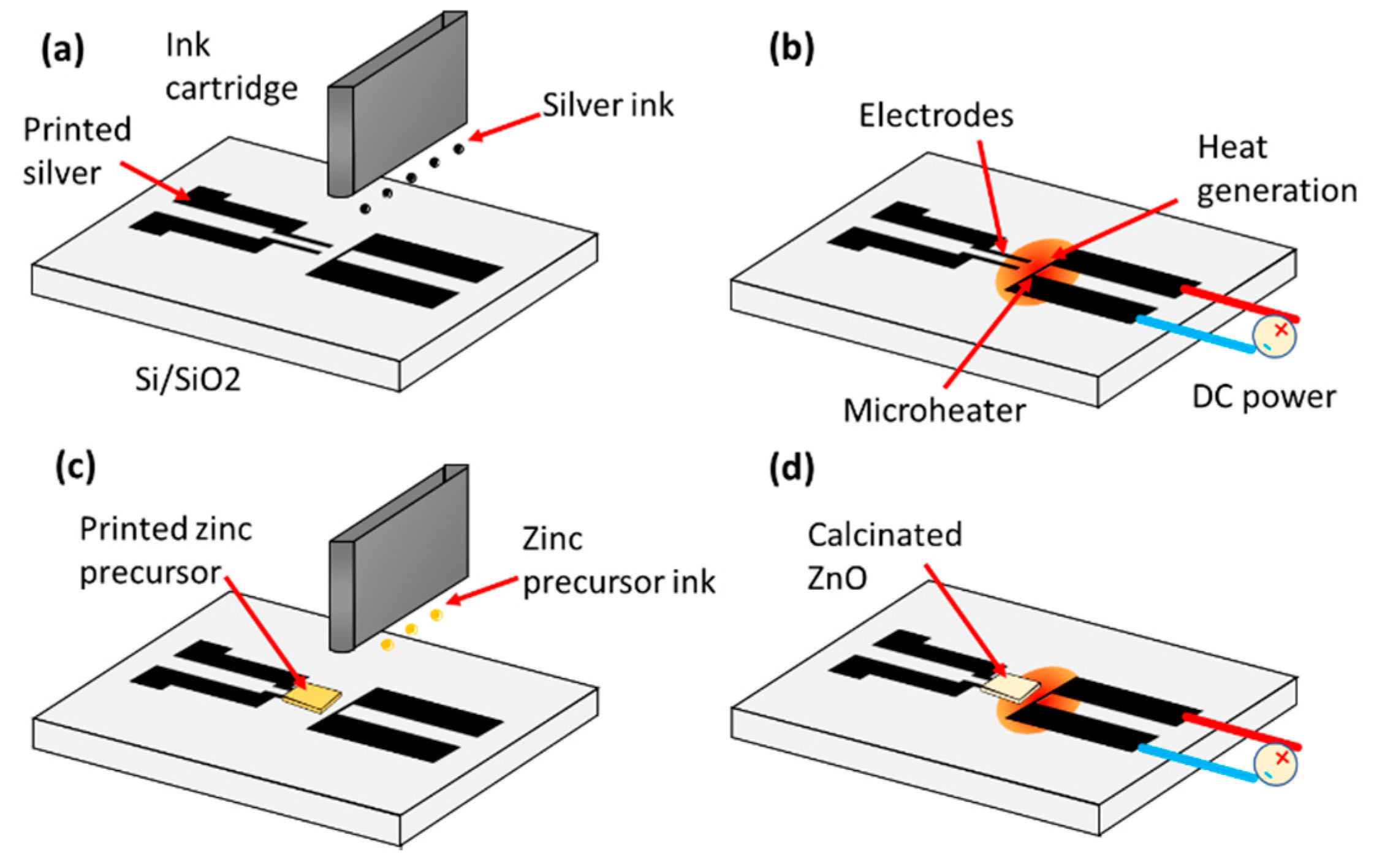
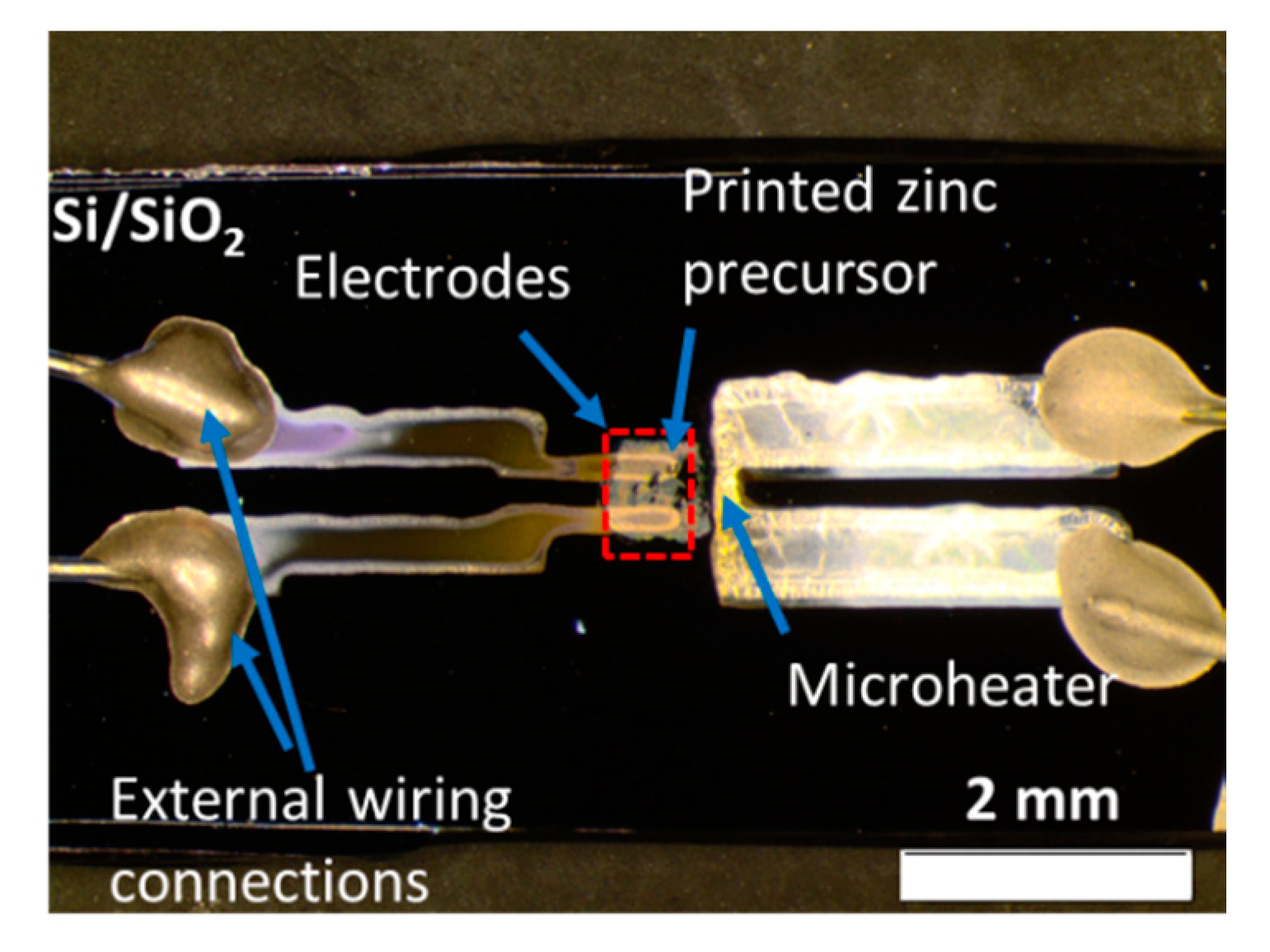
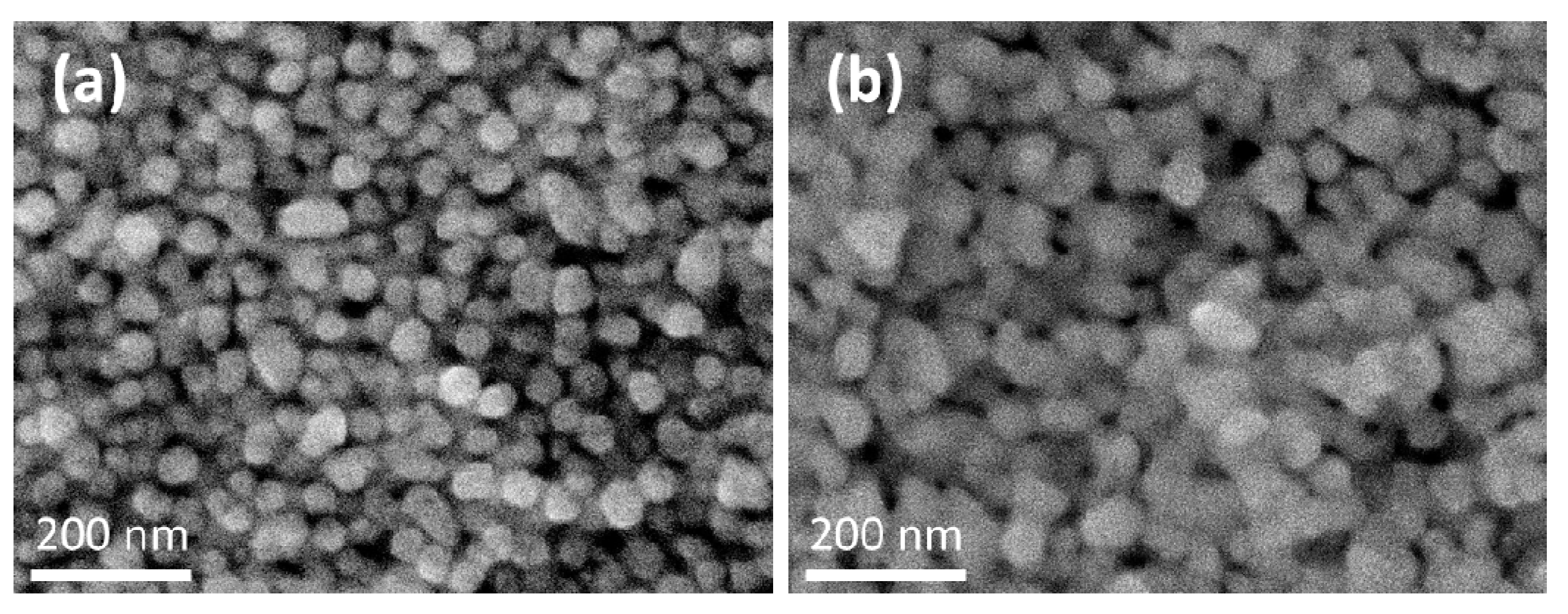
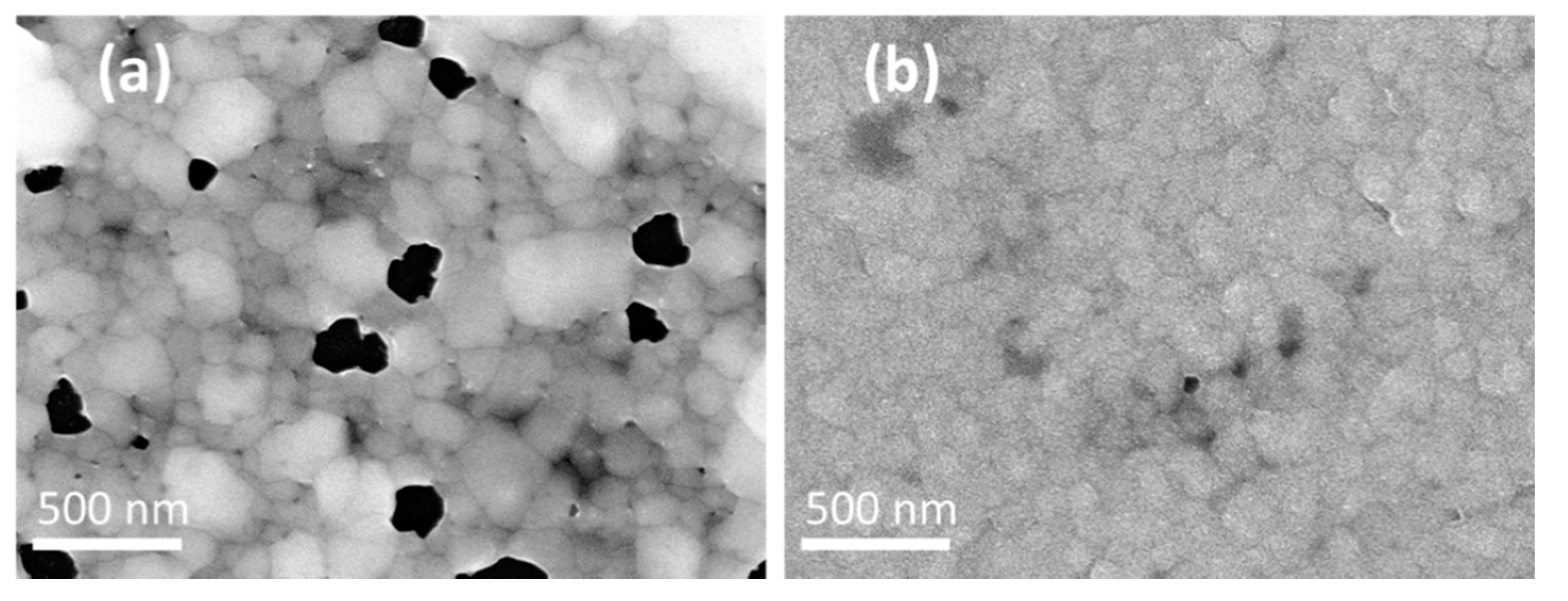
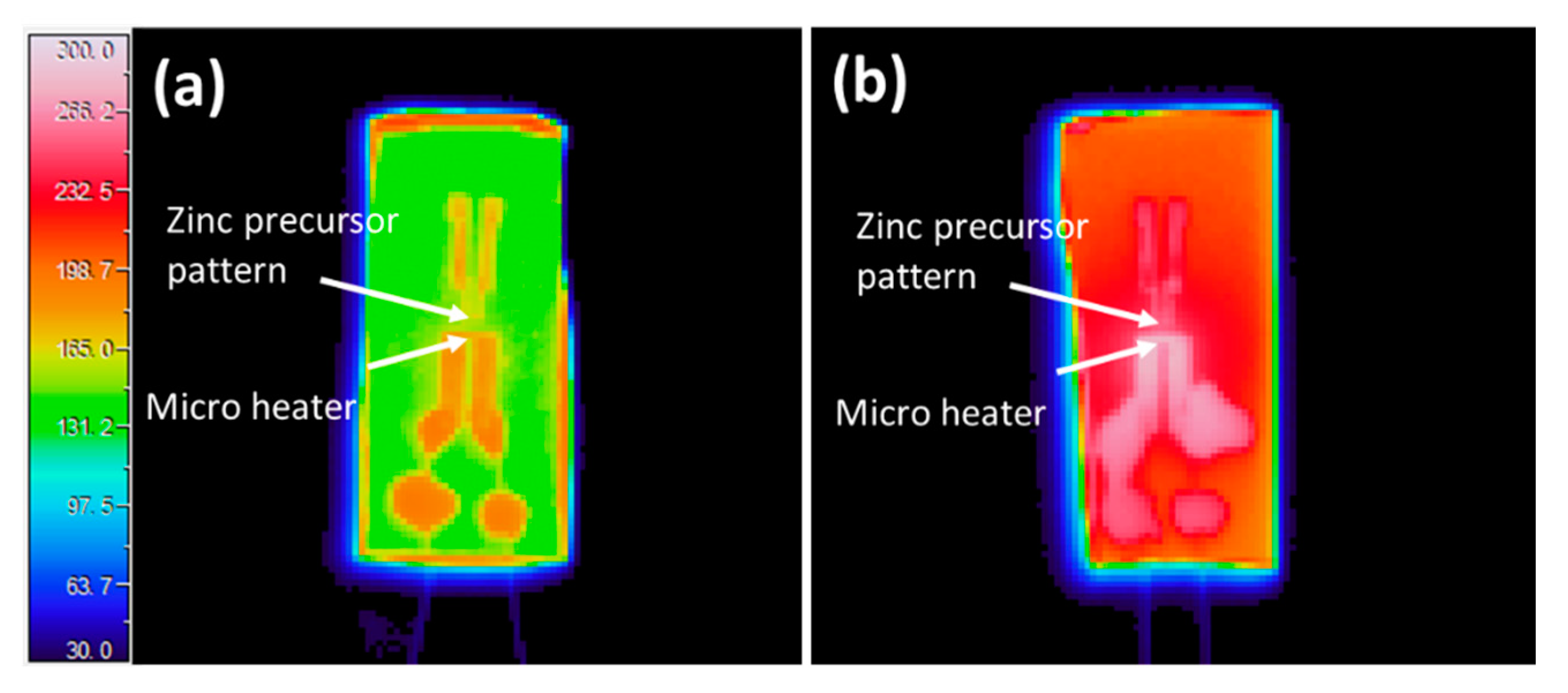
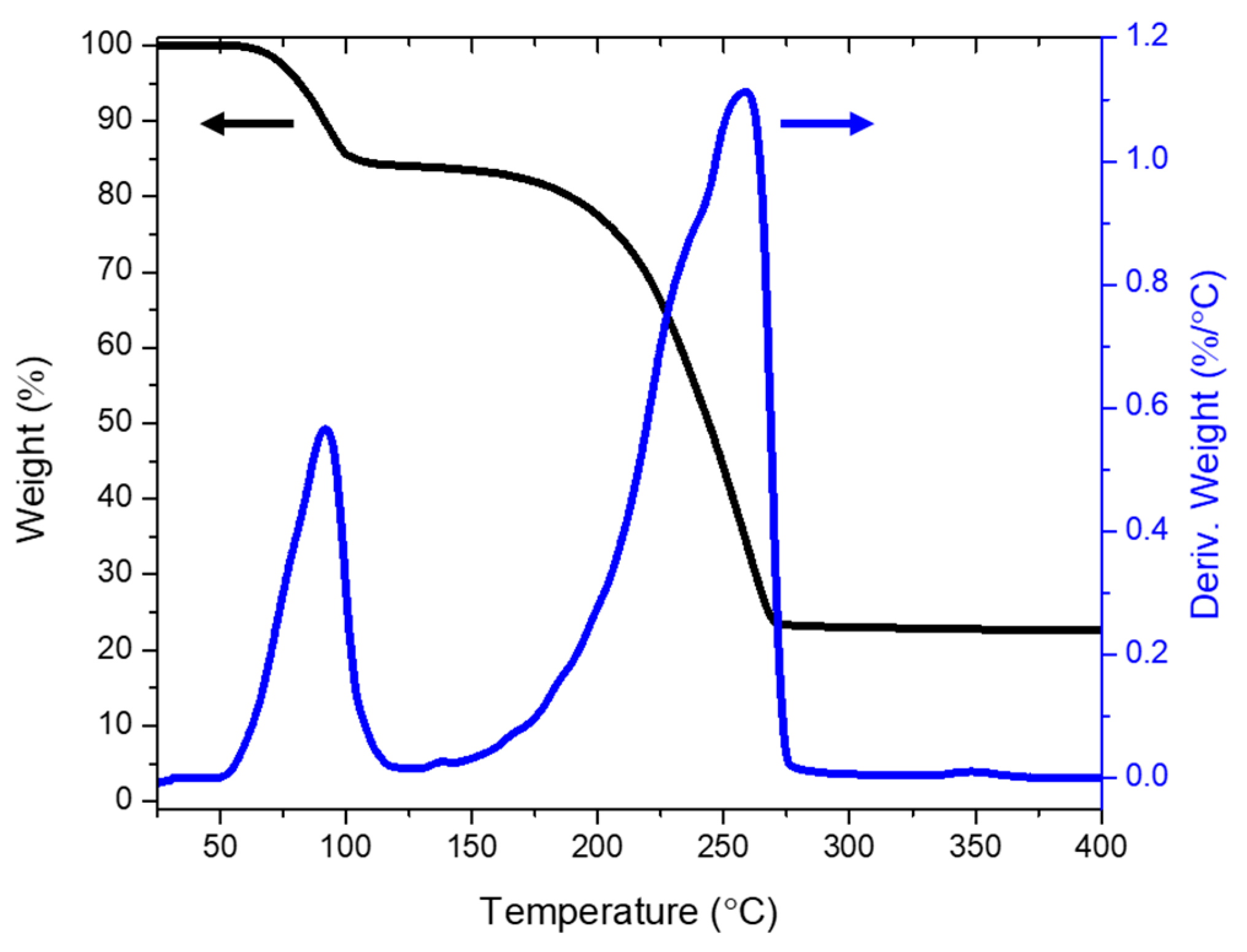
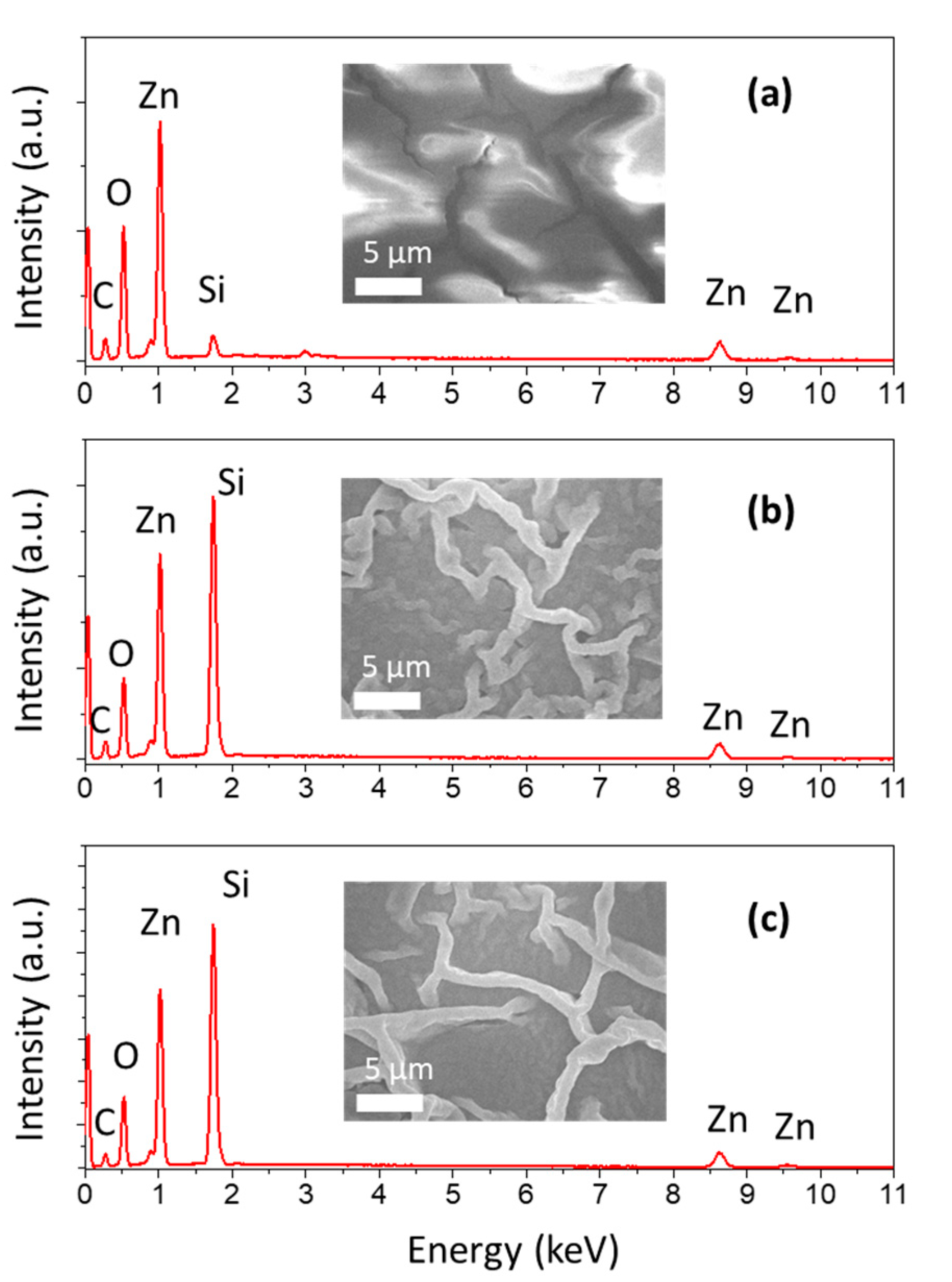
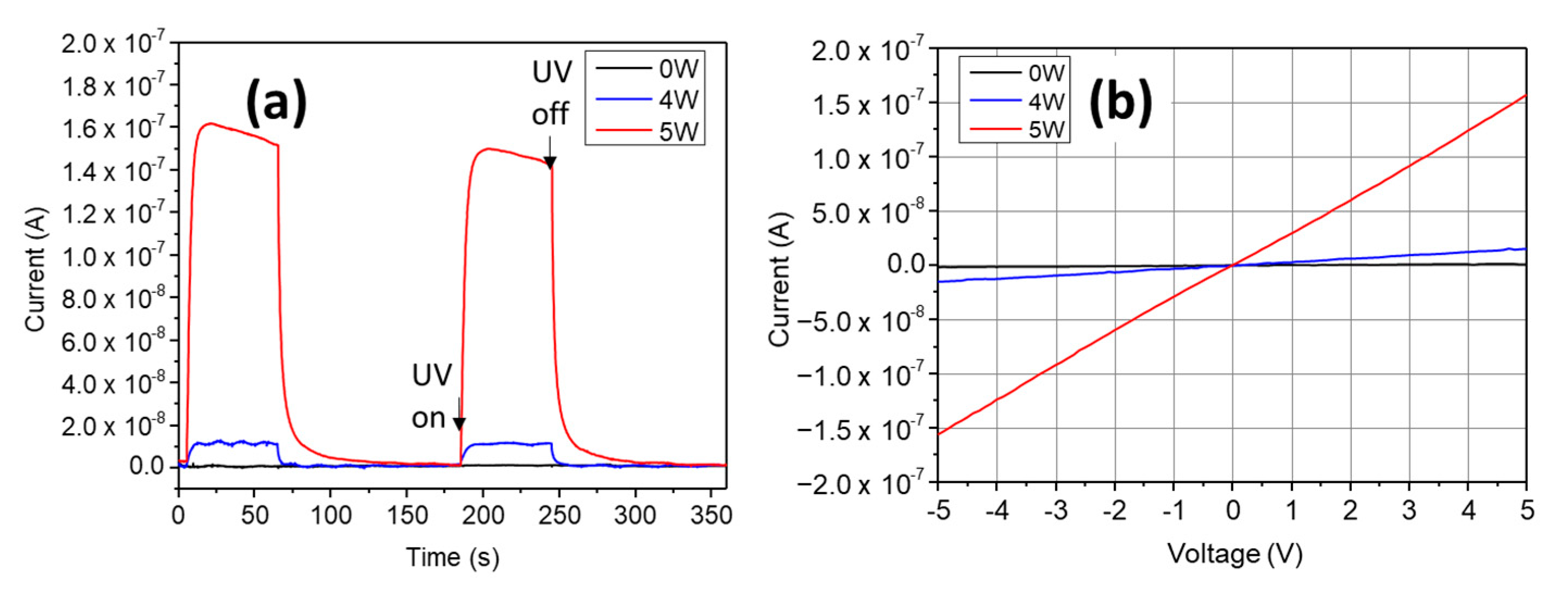
© 2020 by the authors. Licensee MDPI, Basel, Switzerland. This article is an open access article distributed under the terms and conditions of the Creative Commons Attribution (CC BY) license (http://creativecommons.org/licenses/by/4.0/).
Share and Cite
Tran, V.-T.; Wei, Y.; Du, H. On-Substrate Joule Effect Heating by Printed Micro-Heater for the Preparation of ZnO Semiconductor Thin Film. Micromachines 2020, 11, 490. https://doi.org/10.3390/mi11050490
Tran V-T, Wei Y, Du H. On-Substrate Joule Effect Heating by Printed Micro-Heater for the Preparation of ZnO Semiconductor Thin Film. Micromachines. 2020; 11(5):490. https://doi.org/10.3390/mi11050490
Chicago/Turabian StyleTran, Van-Thai, Yuefan Wei, and Hejun Du. 2020. "On-Substrate Joule Effect Heating by Printed Micro-Heater for the Preparation of ZnO Semiconductor Thin Film" Micromachines 11, no. 5: 490. https://doi.org/10.3390/mi11050490
APA StyleTran, V.-T., Wei, Y., & Du, H. (2020). On-Substrate Joule Effect Heating by Printed Micro-Heater for the Preparation of ZnO Semiconductor Thin Film. Micromachines, 11(5), 490. https://doi.org/10.3390/mi11050490






